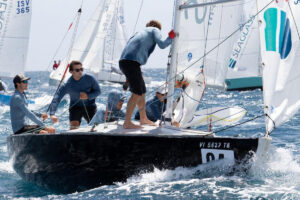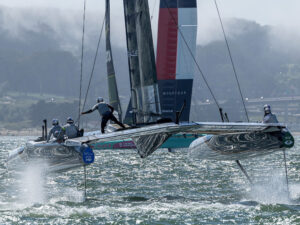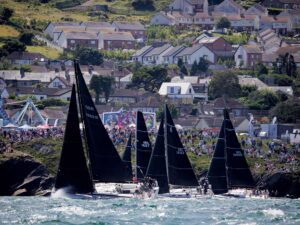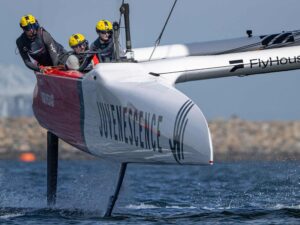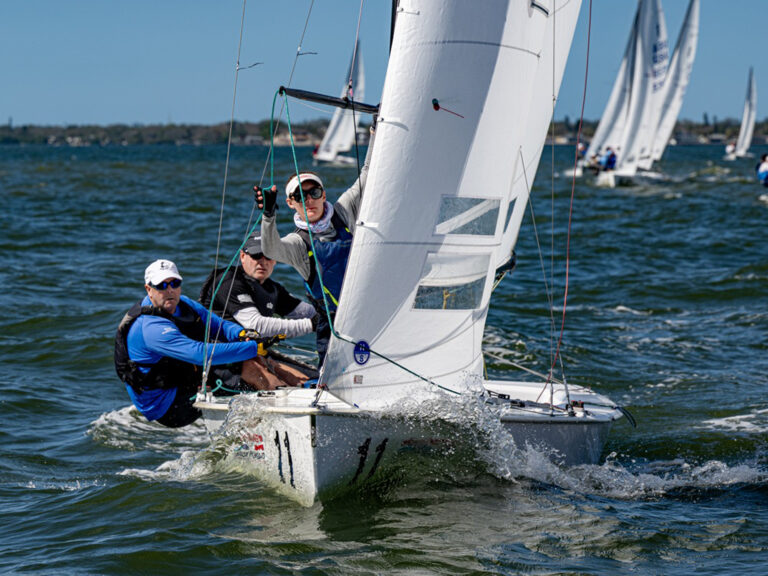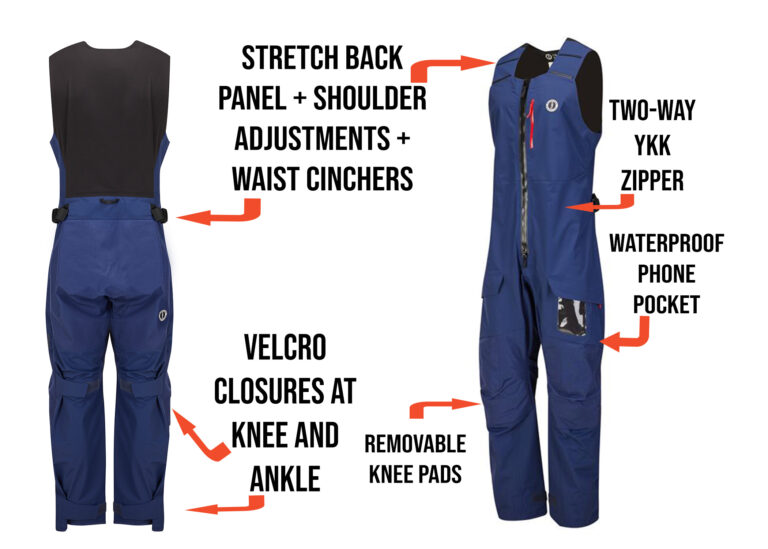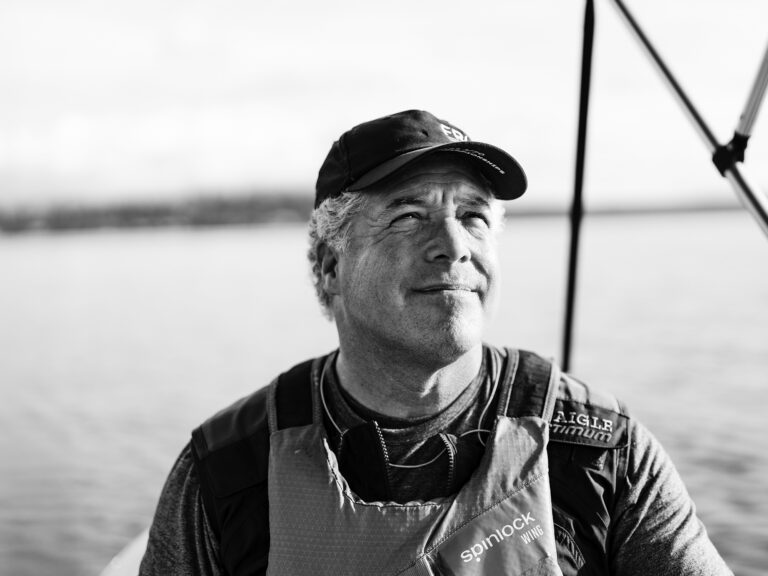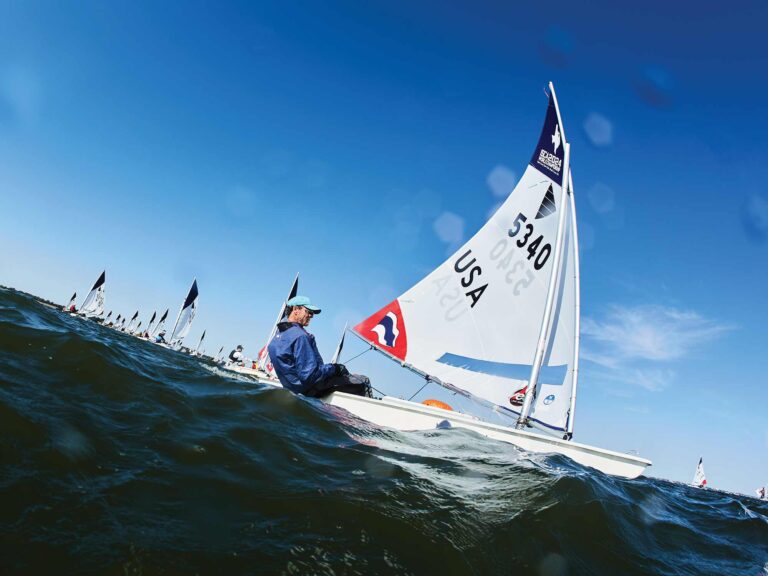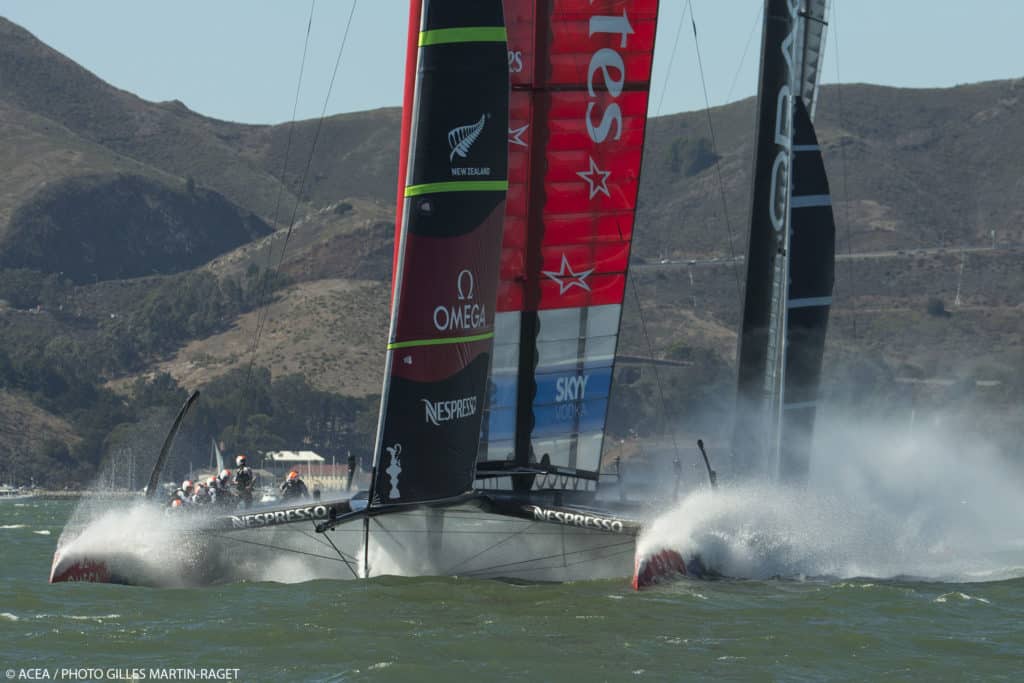
AC34R9and10
At Oracle Team USA’s compound this morning it was business as usual. More than 400 sponsor guests wandering through the compound. Light gym workouts for the sailors, weather briefings, piling on the sailing layers, and happy times with family and friends.
“We’re out of the hole but we have a long way to go,” said the team’s young grinder Rome Kirby while coasting on his stationary bike. “We’re getting there though.”
He says they’re not getting there on boat modifications alone—which have been minor in nature—but on major improvements in muscling their boat 17 around the course. They’ve been studying in-house films taken while racing and refining their techniques, making up for all the critical time they lost when their boat capsized and crumpled into pieces last October. “Everyone forgets that we lost three months while those guys were training hard,” says Kirby.
So they’ve been improving under the pressure of real races, and the team’s new one-race-at-a-time mentality is working for them. In the opening races of America’s Cup 34 they appeared out of sorts and reeling from the Kiwis’ good form and speed, but in recent days they’re showing great form and a renewed sense of purpose. If their Race 9 wire-to-wire win is any indication, they now have pace on both legs of the course, and when they have a strong lead they can defend.
As it was in Race 9, they entered the starting box from the port side and immediately established control to leeward of Emirates Team New Zealand, locking them out from getting a running start, and rocketing off with ETNZ two lengths behind, slow and late to pull the trigger. A couple of touchdowns from foiling didn’t impact their lead, and they rounded Mark 1 with a scant 1-second lead. Fully in control of the race from there they forced the trailing New Zealanders to split at the leeward gate. Oracle went to the right in search of ebb current, forcing ETNZ to the right-hand unfavored gate. That was a big loss right away for the Kiwis and created an 18-second delta. The combination of Ben Ainslie and Tom Slingsby—Ainslie being much more assertive than his first appearance—managed the beat with match-racing precision, keeping the race in the middle of the course and giving the New Zealanders no options to pass. Tack by tack they extended.
Spithill regularly complimented his board managers, a sure sign he likes the change up in their technique. Board management is a critical focus, team members say. Rake adjustments after the tack are allowing them to come out more bow-up out of the tack and then the boards are adjusted for their upwind mode.
As they rounded the weather mark with a 33-second delta, spectators at Marina Green roared in support, happy to see the American team put in a show for the hometown crowd. The final delta was 47 seconds.
“They sailed a great race and left nothing for us,” said Barker at the post-race press conference.
With the entry reversed for Race 10, it was ETNZ with the 10-second head start that comes with the port entry. Port entry enables the team to get deeper in the starting box and set up for the favored leeward end of the starting line. Emirates Team New Zealand set up very close to the layline and did a textbook job of controlling Oracle to weather. As they crept toward the line ETNZ was just a fraction too slow and Oracle had just enough pace to almost sail over the top of them before Mark 1, but the boat touched down briefly, giving Emirates just enough breathing room—just enough too keep an overlap. They entered the mark zone and bore away down the run with tactician Ray Davies repeating, “Nice gain for us guys … nice gainer boys.”
They split at the bottom marks once again with Emirates taking the right-hand gate (looking downwind) and Oracle turning through a much slower rounding to the outside boundary. Oracle had the current advantage, but Davies was sniffing out wind shifts along the left. Tack for tack Oracle was chipping into their lead until they crossed, with 100 meters between them.
“Small gain to him on that one,” said Davies as they crossed.
And then came the dip of the day, with Oracle on starboard, for the first of four lead changes. It was the most exciting Leg 3 of the series and easily the most exciting race thus far. Looking at a marginal cross as they entered the weather mark, Davies said, “Keep it in the bank Dean-o, we may have a dip.” As the two boats approached, the Kiwis dipped, but had enough pace to round the right gate mark and exit clean. Oracle sailed straight to the left gate with a 1-second delta between the two. The crowds were eating it up and the grinders were wheezing. Once ETNZ reached the outside boundary, it was a clean jibe back to the middle and a lead big enough that Oracle could do nothing to get past.
With a 1-to-1 on the day, it extends the series into Tuesday for races 11 and 12. Spithill said they have a long list of things they can work on with the boat and more to learn from in the series. Barker and his wing trimmer Glenn Ashby had the same to say, stating that they never felt they had a sure thing and will continue to push ahead until it’s over.
RACE 9 DATA
Course: 5 Legs/10.02 nautical miles
Elapsed Time: OTUSA – 21:53, ETNZ – 22:40
Delta: OTUSA +:47
Total distance sailed: OTUSA – 11.3 NM, ETNZ – 11.5 NM
Average Speed: OTUSA – 31.63 knots (36 mph), ETNZ – 31.32 knots (36 mph)
Top Speed: OTUSA – 42.52 knots (49 mph), ETNZ – 42.54 knots (49 mph)
Windspeed: Average – 17.6 knots, Peak – 20.8 knots
Number of Tacks/Jibes: OTUSA – 8/6, ETNZ – 8/8
RACE 10 DATA
Course: 5 Legs/10.02 nautical miles
Elapsed Time: ETNZ – 22:00, OTUSA – 22:16
Delta: ETNZ +:16
Total distance sailed: ETNZ – 11.8 NM, OTUSA – 11.7 NM
Average Speed: ETNZ – 32.25 knots (37 mph), OTUSA – 31.76 knots (36 mph)
Top Speed: ETNZ – 43.01 knots (49 mph), OTUSA – 44.98 knots (52 mph)
Windspeed: Average – 18.3 knots, Peak – 22.3 knots
Number of Tacks/Jibes: ETNZ – 7/7, OTUSA – 7/7
STANDINGS
Emirates Team New Zealand – 7
ORACLE TEAM USA – 1

